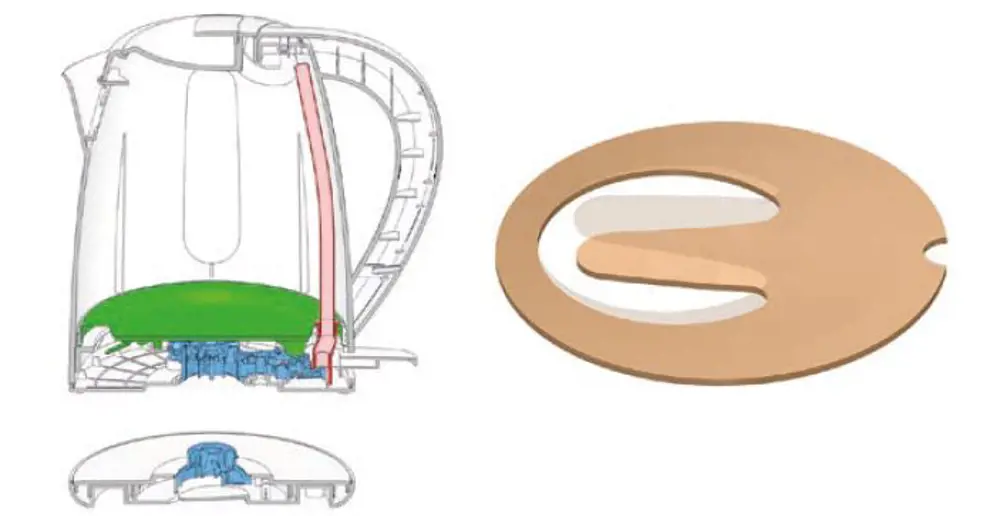
How do kettles know when to switch off?

(left) The green area shows the heating element, when the water boils, steam travels down the steam tube (in red), actuating the bimetallic disc (right) in the blue safety control that disconnects the power supply © Strix Ltd
When a kettle is plugged into an electric outlet and switched on the electric current flows through a metal coil, which is situated either within or under the water. The coil is, in effect, a heating element and its resistance (the material’s efforts to stop electricity flowing through it) turns the electrical energy into heat.
Because a kettle is a sealed unit, the temperature rises quickly within and pretty soon the water boils. So far, so simple. The main problem with the electrical kettle concept has always been how to enable it to switch itself off. In the past they didn’t and many a hotel was evacuated when a left kettle boiled and boiled and set off the room’s smoke detectors.
Now, all electric kettles have an automatic shut-off that stops heating the water when they reach boiling point. Many of the devices that make this happen are based on an invention by a UK engineer, John Crawshaw Taylor OBE FREng. The problem he faced is that a simple thermostat won’t achieve the best result and ensure that the water has fully boiled.
If you fancied a cup of tea on the shores of the Dead Sea your kettle would cut off before the water reached boiling point, whereas if you fancied your brew on the top of a mountain, your kettle would never cut off and would boil all the water away
The boiling point of water changes depending on altitude or the amount of impurities in the water, so a thermostat that stops boiling the water at exactly 100°C presents a problem. At sea level, water boils at 100°C, but for every 150-metre increase in elevation, water’s boiling point lowers by approximately 0.5°C. If you fancied a cup of tea on the shores of the Dead Sea your kettle would cut off before the water reached boiling point, whereas if you fancied your brew on the top of a mountain, your kettle would never cut off and would boil all the water away.
The ingeniously simple solution to the problem comes in the form of a two-layer bimetallic (a metal with two different thermal expansions) disk that ‘flips’ at a specific temperature, similar to a metal jam-pot lid that ‘pops’ out when you open a new jam pot.
The larger-thermal-expansion disk is bonded to a smaller-thermal-expansion one, so that as the temperature rises the combined disk curves so that the faster expanding disk is on the outside, and vice versa as it cools. The cleaver shape of the disk provides a cheap and effective thermostat that snaps suddenly at a certain temperature rather than just bending slowly as it heated.
Another clever feature is that the thermostat is not in the kettle water at all and thus is not tripped by the water temperature, which as established earlier, may not always be 100°C. Instead, it is outside the water and is tripped by a rapid temperature rise induced by the steam that is produced only when the kettle boils.
A channel within the kettle, typically inside the handle, carries steam from the top of the boiling interior down to the thermostat (often near the base), where the temperature rises very rapidly from around ambient to near 100°C as soon as boiling starts. This causes the disk to snap and disconnects the power. The thermostat can now be set to trip whenever the water boils, even if this occurs at different temperatures. If, after the kettle has finished, you listen for a while as it cools you may hear the disk flipping back.
***
This article has been adapted from "How does that work? Kettle switch-off", which originally appeared in the print edition of Ingenia 80 (September 2019).
Keep up-to-date with Ingenia for free
SubscribeRelated content
Electricals & electronics

Accelerometers
Used in earthquake measurements, laptops, planes and even in stargazing apps, today’s accelerometers are much smaller than when they were first developed in 1927. Find out how they detect movement and vibration.

How to maximise loudspeaker quality
Ingenia asked Dr Jack Oclee-Brown, Head of Acoustics at KEF Audio, to outline the considerations that audio engineers need to make when developing high-quality speakers.

Cable fault locator
The winner of the Institute of Engineering and Technology’s 2014 Innovation Award was EA Technology’s CableSnifferTM, which uses a probe and chemical sensing technology to identify faults, saving energy companies millions of pounds each year.

High speed evolution
In December 2010, Eurostar International Ltd awarded a contract for 10 new high speed trains to Siemens. The company has used a system developed over decades to maximise the performance and passenger-carrying ability of its 320km/h trains.
Other content from Ingenia
Quick read

- Environment & sustainability
- Opinion
A young engineer’s perspective on the good, the bad and the ugly of COP27

- Environment & sustainability
- Issue 95
How do we pay for net zero technologies?
Quick read

- Transport
- Mechanical
- How I got here
Electrifying trains and STEMAZING outreach

- Civil & structural
- Environment & sustainability
- Issue 95